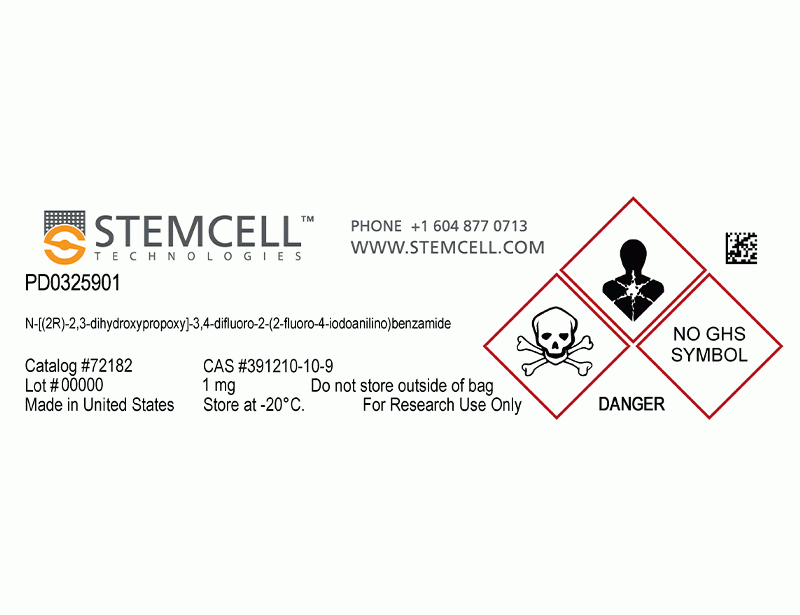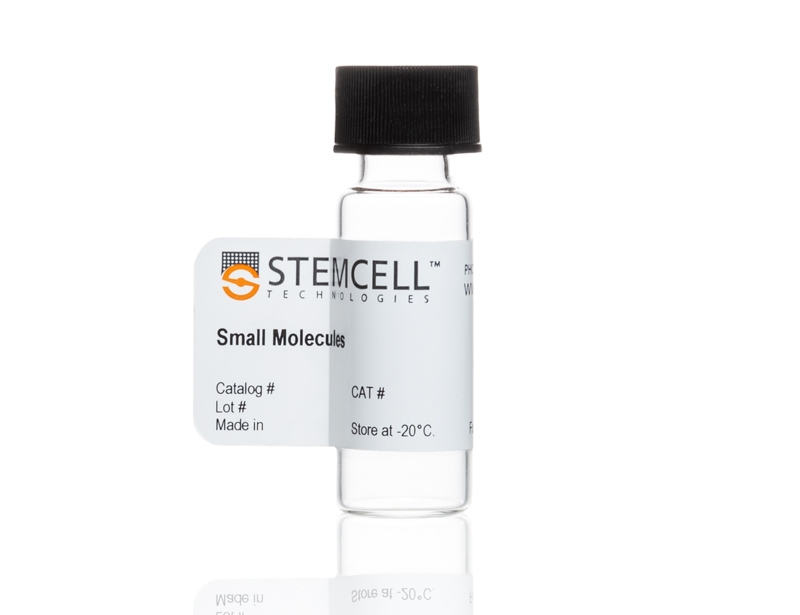概要
PD0325901 is a selective, cell permeable inhibitor of the MEK/ERK pathway that inhibits the activation and downstream signaling of MEK. It is an extremely potent inhibitor, suppressing the phosphorylation of ERK in C26 cells at very low concentrations (IC₅₀ = 0.33 nM) (Bain et al., Barrett et al.).
MAINTENANCE AND SELF-RENEWAL
· Maintains undifferentiated mouse embryonic stem (ES) cells, in combination with CHIR99021, in the absence of LIF (Ying et al.).
· Allows derivation and maintenance of rat ES cells (Buehr et al., Li P et al.).
REPROGRAMMING
· Add at the later stages of reprogramming to select for and expand fully reprogrammed mouse induced pluripotent (iPS) cells (Shi et al., Silva et al.).
· Increases the efficiency of reprogramming human somatic cells to iPS cells, in combination with SB431542 and Thiazovivin (Lin et al.).
· Promotes reprogramming of human somatic cells to iPS cells using only a single factor, OCT4 (Zhu et al.).
· Generates mouse-like or “ground state” iPS cells from human and rat somatic cells, in combination with CHIR99021 and A83-01 (Li W et al.).
MAINTENANCE AND SELF-RENEWAL
· Maintains undifferentiated mouse embryonic stem (ES) cells, in combination with CHIR99021, in the absence of LIF (Ying et al.).
· Allows derivation and maintenance of rat ES cells (Buehr et al., Li P et al.).
REPROGRAMMING
· Add at the later stages of reprogramming to select for and expand fully reprogrammed mouse induced pluripotent (iPS) cells (Shi et al., Silva et al.).
· Increases the efficiency of reprogramming human somatic cells to iPS cells, in combination with SB431542 and Thiazovivin (Lin et al.).
· Promotes reprogramming of human somatic cells to iPS cells using only a single factor, OCT4 (Zhu et al.).
· Generates mouse-like or “ground state” iPS cells from human and rat somatic cells, in combination with CHIR99021 and A83-01 (Li W et al.).
技术资料
| Document Type | 产品名称 | Catalog # | Lot # | 语言 |
|---|---|---|---|---|
| Product Information Sheet | PD0325901 | 72182, 72184, 100-0248 | All | English |
| Safety Data Sheet | PD0325901 | 72182, 72184 | All | English |
| Safety Data Sheet | PD0325901 | 100-0248 | All | English |
数据及文献
Publications (10)
Cell stem cell 2010 DEC
Reprogramming of human primary somatic cells by OCT4 and chemical compounds.
Abstract
Abstract
Nature methods 2009 NOV
A chemical platform for improved induction of human iPSCs.
Abstract
Abstract
The slow kinetics and low efficiency of reprogramming methods to generate human induced pluripotent stem cells (iPSCs) impose major limitations on their utility in biomedical applications. Here we describe a chemical approach that dramatically improves (200-fold) the efficiency of iPSC generation from human fibroblasts, within seven days of treatment. This will provide a basis for developing safer, more efficient, nonviral methods for reprogramming human somatic cells.
Cell stem cell 2009 JAN
Generation of rat and human induced pluripotent stem cells by combining genetic reprogramming and chemical inhibitors.
Abstract
Abstract
PLoS biology 2008 OCT
Promotion of reprogramming to ground state pluripotency by signal inhibition.
Abstract
Abstract
Induced pluripotent stem (iPS) cells are generated from somatic cells by genetic manipulation. Reprogramming entails multiple transgene integrations and occurs apparently stochastically in rare cells over many days. Tissue stem cells may be subject to less-stringent epigenetic restrictions than other cells and might therefore be more amenable to deprogramming. We report that brain-derived neural stem (NS) cells acquire undifferentiated morphology rapidly and at high frequency after a single round of transduction with reprogramming factors. However, critical attributes of true pluripotency--including stable expression of endogenous Oct4 and Nanog, epigenetic erasure of X chromosome silencing in female cells, and ability to colonise chimaeras--were not attained. We therefore applied molecularly defined conditions for the derivation and propagation of authentic pluripotent stem cells from embryos. We combined dual inhibition (2i) of mitogen-activated protein kinase signalling and glycogen synthase kinase-3 (GSK3) with the self-renewal cytokine leukaemia inhibitory factor (LIF). The 2i/LIF condition induced stable up-regulation of Oct4 and Nanog, reactivation of the X chromosome, transgene silencing, and competence for somatic and germline chimaerism. Using 2i /LIF, NS cell reprogramming required only 1-2 integrations of each transgene. Furthermore, transduction with Sox2 and c-Myc is dispensable, and Oct4 and Klf4 are sufficient to convert NS cells into chimaera-forming iPS cells. These findings demonstrate that somatic cell state influences requirements for reprogramming and delineate two phases in the process. The ability to capture pre-pluripotent cells that can advance to ground state pluripotency simply and with high efficiency opens a door to molecular dissection of this remarkable phenomenon.
Nature 2008 MAY
The ground state of embryonic stem cell self-renewal.
Abstract
Abstract
In the three decades since pluripotent mouse embryonic stem (ES) cells were first described they have been derived and maintained by using various empirical combinations of feeder cells, conditioned media, cytokines, growth factors, hormones, fetal calf serum, and serum extracts. Consequently ES-cell self-renewal is generally considered to be dependent on multifactorial stimulation of dedicated transcriptional circuitries, pre-eminent among which is the activation of STAT3 by cytokines (ref. 8). Here we show, however, that extrinsic stimuli are dispensable for the derivation, propagation and pluripotency of ES cells. Self-renewal is enabled by the elimination of differentiation-inducing signalling from mitogen-activated protein kinase. Additional inhibition of glycogen synthase kinase 3 consolidates biosynthetic capacity and suppresses residual differentiation. Complete bypass of cytokine signalling is confirmed by isolating ES cells genetically devoid of STAT3. These findings reveal that ES cells have an innate programme for self-replication that does not require extrinsic instruction. This property may account for their latent tumorigenicity. The delineation of minimal requirements for self-renewal now provides a defined platform for the precise description and dissection of the pluripotent state.
Cell stem cell 2008 JUN
A combined chemical and genetic approach for the generation of induced pluripotent stem cells.
Abstract

 网站首页
网站首页






